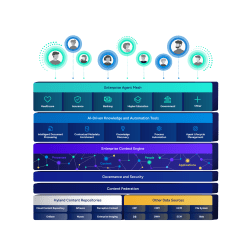What is the accounts payable process?
From purchase orders to proof of payments, AP processes are consistently document-heavy. Here's what a digitized, agile AP structure should look like.

Harness the power of a unified content, process and application intelligence platform to unlock the value of enterprise content.
Learn more
Automate your document-centric processes with AI-powered document capture, separation, classification, extraction and enrichment.
Learn about Hyland IDPIt's your unique digital evolution … but you don't have to face it alone. We understand the landscape of your industry and the unique needs of the people you serve.
 Overview of industries
Overview of industries
Countless teams and departments have transformed the way they work in accounting, HR, legal and more with Hyland solutions.
 Overview of departments
Overview of departments
We are committed to helping you maximize your technology investment so you can best serve your customers.
 Overview of services
Overview of services

Discover why Hyland is trusted by thousands of organizations worldwide.
Hear from our customers
Our exclusive partner programs combine our strengths with yours to create better experiences through content services.
Overview of partners
Join The Shift newsletter for the latest strategies and expert tips from industry leaders. Discover actionable steps to stay innovative.
Register now
Hyland connects your content and systems so you can forge stronger connections with the people who matter most.
Learn about HylandWith our modern, open and cloud-native platforms, you can build strong connections and keep evolving.
 Dig deeper
Dig deeper
Reading time minutes
From purchase orders to proof of payments, AP processes are consistently document-heavy. Here's what a digitized, agile AP structure should look like.

Accounts payable (AP) is an essential business function that affects profitability and operations throughout your organization. On a fundamental level, it’s the total amount owed by your organization to suppliers and vendors for goods and services purchased. This amount shows up as a liability on the balance sheet and impacts the health of your organization’s cash flow.
The AP process is responsible for paying suppliers and vendors for goods and services purchased by the company. AP departments typically handle incoming bills and invoices, but may serve additional functions depending on the size and nature of the business.
The AP process can be broken down into four steps, although the complexity and length of each may differ from company to company. The steps are:
Learn more | The benefits of AP automation
Despite falling under the category of back-office functions, AP is a critical business process. The efficiency and productivity of an AP department are dependent on how its employees can manage the procure-to-pay cycle in a timely manner.
A well-managed AP department ensures:

An Ardent Partners study found that best-in-class organizations spend 70% less on invoice processing and need a small fraction of the typical time it takes to process an invoice. Explore the top benefits of AP automation and learn how Hyland can help you produce a significant ROI.
AP departments face challenges that prevent them from optimizing their processes. AP managers are also under pressure to do more with less while transforming their departments from cost centers to profit centers.
The problems commonly faced by AP professionals include:
Additional insights | What a paperless AP process looks like
To tackle the issues that prevent AP teams from being efficient, there are a set of best practices that help streamline the process from start to finish.
> Read more | Accounts payable automation: Real-world success stories



